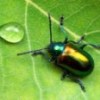
In California, the pesty ant that invaded our kitchen was the Argentine ant (Linepithema humile). In Tucson, we had South American rover ants (Brachymyrmex patagonicus). Here in Illinois, our kitchen ant is a native species, Tapinoma sessile. At any given moment we probably have two or three wandering about our countertops.
The common name for this small brown insect is the Odorous House Ant, a reference to both the strong blue-cheesy odor these ants emit when crushed and to their habit of foraging indoors for food. They don't normally nest indoors, though, they prefer to be outdoors where they can incubate their brood under a sun-warmed rock or pile of last year's leaves.

A pile of spring brood, mostly pupae of males and queens.
The "pest" status of Tapinoma sessile has more to do with our human distaste for stray insects than anything the ant itself does. They do not cause structural damage, they do not transmit diseases, nor do they bite or sting. Instead, they wander about looking for crumbs. Nonethless, if you find the idea of a few harmless ants in your kitchen upsetting, they are best controlled by keeping a clean house, free of the little bits of food that attract them in.

photo details (all photos): Canon MP-E 65mm 1-5x macro lens on a Canon EOS 50D
ISO 100, 1/250 sec, f/11-f13, flash diffused through tracing paper

Our colony of these lives in the wall of the building and come in through the window frames.
Aw, how cute is that. Sadly I don't have any ant in my kitchen :(
Blue Cheese??
I sense a marketing opportunity....perhaps high protein salad sprinkles?
There are a ton of these in my house, even though we don't really leave food out. Is there an effective repellent to keep them outside? I don't really want to kill them, but they are obnoxious--I get a little creeped out by the idea of them crawling on me when I'm sleeping (harmless or not).
Here's a picture of them coming out of an electrical outlet at my house last week. http://antfarm.yuku.com/topic/8203
Old timey myrmecologist William Morton Wheeler once wrote they had rancid coconut odor. I tested this by burying a piece of coconut under ground for a week, then dug it up and sniffed. Yep, that's pretty much it.
I can't imagine much of a market for rotten coconut sprinkles!
A cheerful observation, these guys came back gang-busters after the geographically isolated population of the invasive Tetramorium tsushimae mysteriously died out in my yard! Several other natives are doing well now, too.
I love bug girl! Some day I want to be just like her!
You best implement a killing plan as opposed to repellent. If left unchecked for a relatively short period of time.....their population and number of colonies grow. They are harmless from a bite/sting perspective but can become a major nuisance quickly......crawling all over you and inside your home. I've been battling them inside and outside my home for about a month now. I'm slowly winning the battle. Follow their trails, locate their colonies, exterminate. Various pest control products for this ant can be found @ http://insects.tamu.edu/extension/bulletins/1-2061.htm.